What Factors Are Driving the Current Tungsten Market?
The tungsten market has experienced significant volatility throughout 2025, with prices reaching unprecedented levels due to a complex interplay of supply constraints, policy changes, and evolving demand patterns. The price movements reflect fundamental market shifts rather than temporary fluctuations, indicating a potentially sustained period of elevated prices.
The first half of 2025 has witnessed remarkable price increases across the tungsten value chain, with black tungsten concentrate (65%) reaching 172,500 RMB/metric ton-degree – representing a substantial 20.8% increase since January. Similarly, ammonium paratungstate (APT) prices have climbed to 252,000 RMB/ton, a 19.7% year-to-date increase.
European markets have experienced even more dramatic price movements, with APT prices surging to 430 USD/ton-degree (a 30.3% year-to-date increase) and tungsten ferroalloy closing at 51.85 USD/kg Mo (up 17.8% since January).
"These price movements are driven by multiple factors including policy regulation, explosive demand, and geopolitical dynamics," notes Shanghai Metal Market in their June 2025 analysis.
Long-term contract prices for tungsten concentrate have now stabilized in the 171,000-172,000 RMB/metric ton-degree range, indicating that market participants expect current price levels to persist in the near term.
How Is China's Dominance Shaping Global Tungsten Markets?
China's commodity influence creates ripple effects throughout international markets. The country controls approximately 52% of global tungsten reserves, holding 2.4 million tons out of the worldwide total of 4.6 million tons. This resource advantage, combined with strategic policy decisions, gives China significant influence over global tungsten markets.
Since 1991, China has designated tungsten as a "strategically advantageous mineral" under protective mining regulations. This status has allowed the implementation of a comprehensive regulatory framework across four dimensions:
- Industry access restrictions limiting new entrants
- Total quantity production controls maintaining supply discipline
- Export restrictions, including the quota system implemented in February 2025
- Tax guidance mechanisms steering industry development
The implementation of tungsten export controls in February 2025 has dramatically reshaped global trade patterns. While exports of tungsten intermediates from China have declined, exports of finished tungsten products have increased substantially. Customs data shows cemented carbide product exports rose approximately 31% year-on-year (January-May 2025), while drill and drilling machine exports increased by approximately 22.3% over the same period.
This shift demonstrates China's strategic pivot toward exporting higher-value tungsten products while restricting the outflow of raw materials and intermediates – a move that strengthens its position in the global value chain while also creating supply challenges for international processors.
Why Are International Supply Alternatives Limited?
Despite strong incentives to develop alternative tungsten sources, international supply growth faces significant beneficiation challenges that limit its ability to offset Chinese market dominance. New tungsten concentrate production outside China remains constrained by geological, technical, and economic factors.
South Korea's Sandong tungsten mine represents one of the few significant new projects, scheduled to begin production in the second half of 2025. This operation is expected to produce approximately 2,300 tons annually (tungsten trioxide equivalent), though this represents only a fraction of global demand.
Kazakhstan's Boguty tungsten mine began operations in late 2024 and is expected to produce around 5,000 metric ton-degrees of tungsten concentrate in 2025. Beyond these projects, other international mining developments show minimal progress or expansion potential.
The international tungsten value chain suffers from structural weaknesses beyond mining capacity. Many countries lack comprehensive tungsten smelting and processing capabilities, creating a processing bottleneck that limits the conversion of concentrate into intermediate and finished products.
This processing capacity gap creates price disparities between domestic Chinese and international markets. Lower overseas ore prices compared to domestic Chinese prices have created import opportunities for China, which has increased tungsten concentrate imports by 46.3% year-on-year (January-May 2025), reaching 5,153 tons.
"The incomplete overseas smelting sector results in lower ore prices outside China, which has created a significant import opportunity," notes SMM in their analysis of international supply dynamics.
This structural imbalance reinforces China's position as both a major producer and strategic importer of tungsten resources.
What Demand Factors Are Influencing the Tungsten Market?
Tungsten demand patterns are evolving across both traditional and emerging sectors, with high-end manufacturing applications showing steady growth, particularly in humanoid robotics components, advanced cutting machines, and precision engineering applications.
Traditional sectors display mixed performance, with photovoltaic tungsten wire demand remaining subdued while conventional industrial applications show stability rather than growth. This divergence in demand patterns contributes to market complexity and price volatility.
Perhaps the most significant demand factor in 2025 has been the acceleration of military and strategic consumption. Geopolitical tensions have substantially boosted tungsten demand in defense applications throughout the year.
"Tungsten remains irreplaceable in military products like missile components, cutting tools, and armor-piercing munitions," according to SMM's analysis of strategic material requirements.
European defense initiatives, such as the "Celestial Law Program," have accelerated military modernization efforts that rely heavily on tungsten-containing components. The critical raw materials facility established by the EU has prioritized tungsten among the strategic metals necessary for both defense and clean energy transitions. Ongoing international conflicts have further driven demand for tungsten in military applications, creating a demand floor that transcends typical industrial consumption patterns.
The combination of strategic demand and emerging industrial applications creates resilient support for tungsten prices, even as some traditional consumption sectors show less robust growth.
What Is the Current Supply-Demand Balance?
The tungsten market is experiencing a period of structural tightness that extends beyond cyclical patterns, creating persistent upward price pressure. This tightness stems from multiple converging factors affecting both volatile supply-demand dynamics.
On the supply side, historically low global tungsten inventories have limited the market's ability to absorb demand fluctuations. This inventory situation coincides with declining domestic Chinese tungsten concentrate output and deteriorating ore grades at existing mines worldwide.
The slow development of new international production capacity, combined with export control measures restricting global supply flows, has further constrained available material. These supply limitations occur against a backdrop of resilient and, in some sectors, growing demand.
The rapid price increases across the tungsten value chain have created profitability imbalances between different market segments. Raw material prices (tungsten concentrate) have risen sharply, while intermediate product prices (tungsten powder and chemicals) have been slower to adjust.
This price divergence has compressed margins for processors and manufacturers, creating economic stress points along the value chain. Such profitability pressures may limit further immediate price increases despite tight supply, as downstream buyers resist higher costs that cannot be easily passed on to end users.
The current market dynamic represents a delicate balance between physical supply constraints and economic constraints on price movements, creating the conditions for sustained volatility rather than a simple upward price trajectory.
What Is the Outlook for Tungsten Markets?
The tungsten market appears poised for continued volatility within an elevated price range, with several key factors shaping the medium to long-term outlook. These factors suggest that current market conditions represent a structural shift rather than a temporary aberration.
In the medium term, reduced domestic Chinese tungsten concentrate output is likely to persist as a feature of the market landscape. The declining ore grades that have challenged miners in recent years are becoming the "new normal" for existing operations, limiting their ability to increase production even at higher price levels.
International supply development remains sluggish despite price incentives, suggesting that meaningful supply growth from non-Chinese sources will take time to materialize. Current low inventory levels throughout the supply chain create potential for replenishment demand once market participants adjust to higher price expectations.
Rising terminal consumption in strategic and advanced manufacturing sectors provides a solid demand foundation, particularly as high-end applications continue to grow even during periods of broader economic uncertainty.
"These factors collectively point toward a prolonged pattern of high-range price volatility rather than a return to historical price levels," concludes SMM in their market outlook assessment.
In the longer term, the tungsten industry may be undergoing a fundamental restructuring. Profit distribution along the value chain is likely to shift as participants adjust to new market realities. Supply chain security concerns may drive strategic stockpiling by both private companies and governments, adding another layer of demand.
Processing capacity development outside China could accelerate as a response to supply security concerns, potentially changing global trade flows over time. New exploration and mining projects may receive increased investment, though the typical development timeline for tungsten mines suggests any supply response will be gradual rather than immediate.
Recycling and recovery of tungsten from secondary sources could gain increased importance as a supply supplement, particularly in developed economies with established collection systems and processing capabilities. Additionally, investors have been monitoring tungsten alongside the all-time high gold analysis as part of broader strategic metals portfolios.
FAQ: Understanding the Tungsten Market
What are the main uses of tungsten in modern industry?
Tungsten's unique properties make it essential in numerous applications. Cemented carbide tools and components account for approximately 60% of consumption, with other significant uses including high-temperature alloys for aerospace and power generation, electronics and electrical contacts, military applications including armor-piercing ammunition, chemical catalysts, and specialized compounds.
How do tungsten export controls impact global manufacturing?
Export controls create cascading effects throughout global supply chains, including reduced availability of intermediate tungsten products, price increases for tungsten-containing components, longer lead times for specialized tungsten materials, and incentives for stockpiling. These effects can lead to potential manufacturing disruptions in tungsten-dependent industries and accelerate efforts to develop alternative supply sources.
What countries hold the largest tungsten reserves outside China?
While China dominates global tungsten reserves with 52% of the total, several other countries hold significant resources. Australia represents approximately 12% of global reserves, Russia approximately 9%, and Vietnam approximately 3%. Other countries with notable reserves include Canada, Bolivia, Portugal, and the United States.
How does tungsten recycling impact market dynamics?
Tungsten recycling represents an increasingly important supply component, providing approximately 30-40% of tungsten supply in developed economies. Cemented carbide scrap offers the highest-quality recycled tungsten, and economic incentives for recycling increase during periods of high prices. However, processing capacity for tungsten-containing scrap remains concentrated in a few countries, limiting the immediate impact of recycling on supply constraints.
Further Exploration:
Readers interested in learning more about the tungsten market can explore related educational content, such as the comprehensive tungsten supply chain analysis from Tungsten Metals Group, which offers detailed insights into future market trends. Additionally, the global tungsten market outlook from Core Consultants provides valuable perspectives on navigating the shifting landscape through 2030.
Ready to Capitalise on the Next Mineral Market Rally?
Stay ahead of major mineral discoveries on the ASX with instant, AI-powered alerts from Discovery Alert's proprietary Discovery IQ model, giving you the same market edge that early investors in tungsten enjoyed. Explore how significant discoveries can generate substantial returns by visiting the Discovery Alert discoveries page and start your 30-day free trial today.




